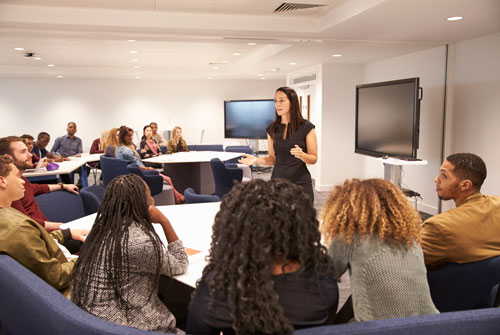Most of you are probably looking at the title thinking, “What does this have to do with Opticianry?” Well, I will explain. Several years ago, I landed an amazing opportunity to teach Opticianry at Goodwin College. I still pinch myself every day and tell my students I am the lucky one to have to the opportunity to share what I know and have learned with them. That said, we don’t often think about the educational aspect of how many of us have become opticians. It is my job to teach students to become opticians, therefore, I must understand how students learn. Last year, I participated in the Goodwin College Universal Design for Learning project, funded through a grant from the Davis Educational Foundation which gave me an opportunity to improve our students’ learning.
 College for most of us was listening to the professor lecture for three hours, go home, and do our assignments. Think about that for a minute. How effective do we think that teaching method is?
College for most of us was listening to the professor lecture for three hours, go home, and do our assignments. Think about that for a minute. How effective do we think that teaching method is?Unfortunately, it isn’t very effective. Our classrooms are filled with a variety of learners. Some students can listen, others need to see an image, some need to read the information. A traditional college educator presents information in only one way, which does not work for all students. The Universal Design of Learning helps reach the diversity of learners in the classroom.
Universal Design of Learning, or UDL, is a scientifically valid framework for proactively designing curriculum, implementing instruction, and assessing learning, thus affording all students not only equal access to information but also to learning. Universal Design of Learning has three basic principles: Multiple means of representation, expression, and engagement. Multiple means of representation of learning content gives learners diverse ways to acquire information and knowledge. For example, we can provide audio, digital text, and images so all students can engage in the material while accessing the content. Multiple means of action and expression provide learners with alternative avenues for demonstrating what they know. For example, we can allow students the options of written assignments, oral presentation, or video where it is applicable. Obviously, this is not possible for all assignments, but it is a great option when it can be used. Multiple means of engagement and collaboration help tap into learners’ interests, offering appropriate challenges, and increasing motivation. Engagement is big in my classroom. I am always thinking of ways to engage students in the learning environment, especially with some of the dry topics we have to cover, such as theories of light. We try to include quick games for reviews, such as kahoot and quizizz. I often do an Optical Jeopardy review before finals. One of my favorite ways to engage students is to learn cancelling and compounding prism by dancing. Sounds silly, but it works.













